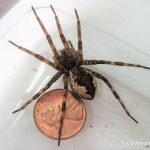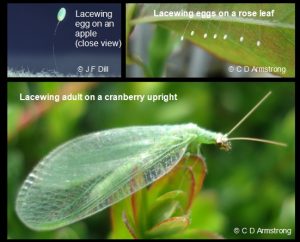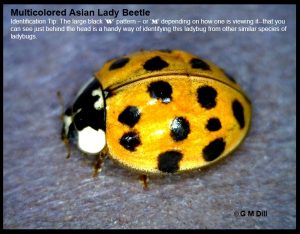Bulletin #7150, Beneficial Insects and Spiders in Your Maine Backyard
Bulletin #7150, Beneficial Insects and Spiders in Your Maine Backyard (PDF)
Prepared by Colin Stewart, homeowner/greenhouse IPM specialist, and Nancy Coverstone, Extension educator, University of Maine Cooperative Extension.
Updated and expanded from Beneficial Insects in Your Backyard, #2490, by Barbara Murphy, Nancy Coverstone, and James Dill, , University of Maine Cooperative Extension.
For information about UMaine Extension programs and resources, visit extension.umaine.edu.
Find more of our publications and books at extension.umaine.edu/publications/.
Table of Contents
- Predators and Parasitoids
- A Top Eleven List of Beneficial Insects and Spiders
- Attracting and Sustaining “Good Bugs”
- Best Flower Structures for Beneficial Arthropods
- Managing Your Yard as Habitat for Beneficial Arthropods
- Avoid Problems by Keeping Plants Healthy
- Encourage or Import?
- Everything Is Connected
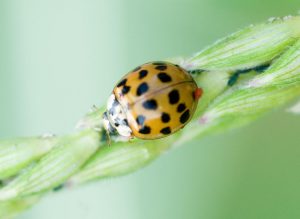
Insects, spiders, predatory mites, and other arthropods are considered beneficial when they eat arthropods that humans consider undesirable. Few arthropods are actually pests; of all insect species, over 97 percent of those usually seen in the home landscape are either beneficial or are “innocent bystanders.” Managing our yards as habitat for beneficial arthropods—commonly called “natural enemies” or “beneficials”—is a great way to minimize pest problems, often greatly reducing or eliminating pesticides. This fact sheet describes a long-term, systems-wide approach to manage arthropod pests.
Predators and Parasitoids
There are two categories of beneficial arthropods: predators and parasitoids. Both can effectively control insect and mite pests in your home landscape.
Predators are organisms that kill and feed on prey. They are generally larger than their prey. Parasitoids, on the other hand, are typically smaller than their hosts and lay eggs on or within them. When the eggs hatch into larvae, these larvae develop and feed on these host insects, causing their death. In some cases, adult parasitoids will act like predators by feeding on the blood of host insects without laying eggs, weakening them if not killing them outright. While predators attack many pests to complete development, parasitoids kill only one or a few pests each.
A Top Eleven List of Beneficial Insects and Spiders
Spiders
Description: Spiders have no antennae and two body parts: the cephalothorax, containing the eight legs, eyes, and mouth; and the abdomen, containing the digestive organs, genitals, and spinnerets. Spiders are an incredibly diverse group with roughly 3,000 described species in North America. While most have venom glands of some kind, spiders rarely bite people. Brown recluse and black widow spiders are not normally found in Maine.
Value in the home landscape and garden: All spiders are predators, and most feed on insects caught in a web. Others, such as jumping spiders and wolf spiders, are active hunters relying on excellent vision to kill their prey. Crab spiders, another commonly encountered group, ambush their prey. A recent study1 indicates that spiders are often the most abundant predators, as a group, on a wide range of plant material in the home landscape.
Green and brown lacewings
Description: Lacewings lay their eggs at the end of long stalks, presumably to protect them from ants and other lacewing larvae. The larvae of both green and brown lacewings are alligator-like with sickle-shaped mandibles. Adult green lacewings are approximately three-fourths of an inch long and pale green, with large copper-colored eyes. They are attracted to lights at night, and can produce a noxious odor when handled. Brown lacewing adults are tan or brown and about half the size of green lacewing adults.
Value in the home landscape and garden: Green lacewing larvae are called “aphid lions” for good reason; they attack and consume large numbers of aphids, mites, lace bugs, and other small insects. Pollen, nectar and even honeydew sustain the generally nonpredaceous adults. Green lacewing larvae can be purchased commercially and offer a safe, though sometimes costly, nonchemical alternative for controlling aphids and lace bugs.
Lady beetles
Description: Most people recognize the dome-shaped, often brightly colored adults, also known as “ladybugs” and ladybird beetles, that range in size from one-sixteenth to three-eighths of an inch long. Colors are highly variable and include orange, black, pink, or yellow. Spots may or may not be present.
The adult female beetle lays groups of 10–50 orange, football-shaped eggs, usually on upper leaf surfaces or twigs. The eggs hatch into spiny, black and orange, alligator-like larvae. Some lady beetle larvae that feed on mealybugs have a white, waxy covering (similar to that of mealybugs). After feeding, the larvae pupate, usually on the underside of the leaf near their prey, and emerge as adults. Lady beetles spend the winter as adults in protected areas and can live for 11 months or longer, some as long as two to three years.
The multi-colored lady beetle, (Harmonia axyridis), also known as the Halloween lady beetle, while beneficial, often enters homes in large numbers. You can prevent their entry by carefully examining the exterior of the house, sealing cracks and crevices, and screening vents using 20 mesh screen or smaller.
One of the few pests in this group is the Mexican bean beetle (Epilachna varivestis), which in its adult stage is yellow with 16 black spots on its wing covers.
Value in the home landscape and garden: Both the larvae and adult lady beetles are voracious predators that can eat hundreds of aphids in their lifetime. They also eat insect eggs, mealybugs, and other soft-bodied insects and mites. Some species of lady beetles have favorite prey, as indicated by the names given to the “mealybug destroyer” and the “spider mite destroyer.” Flowering, pollen-producing plants in the landscape attract lady beetles.
Ground beetles
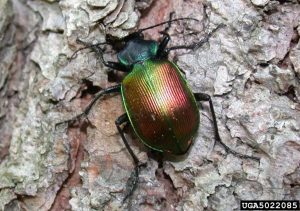
Description: Most of these are shiny brown, black, or blue-black insects ranging in size from one quarter to over one inch long, with long legs and long antennae. Most ground beetles are nocturnal and have prominent jaws used to kill caterpillars (including armyworms, cutworms, and grubs) and other insects, as well as small snails and slugs. Both adults and larvae are predators. One species, Calosoma sycophanta, is a climber.
Value in the home landscape and garden: One Calosoma sycophanta larva can consume 50 large gypsy moth caterpillars in two weeks, while a pair of adults can devour over 300 gypsy moth caterpillars and pupae per year. Ground beetles typically have one generation per year, and some adults can live for two to four years.
Praying mantids
Description: This large, highly distinctive insect is tan, green, or gray, may be up to three inches long, and has large, bulging eyes on the sides of its head. A distinctive feature is its enlarged first pair of legs, which are held out in front of its body as though it were praying. There is one generation per year. Females deposit a tan, bubbly egg mass on branches near the end of the summer. The egg mass, which hardens, contains over 200 eggs.
Value in the home landscape and garden: Because these insects feed on anything they can catch, including honey bees, each other, and other beneficial insects, their value in reducing the numbers of key pests in the garden and landscape is questionable. Contrary to popular belief, they are not protected by any state or federal laws.
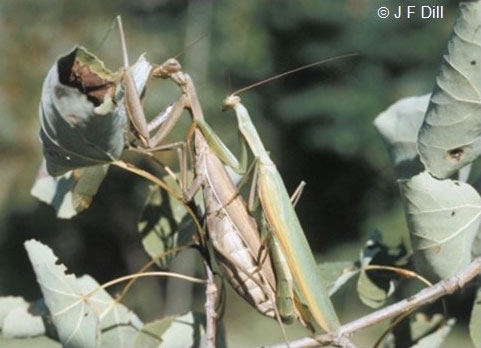
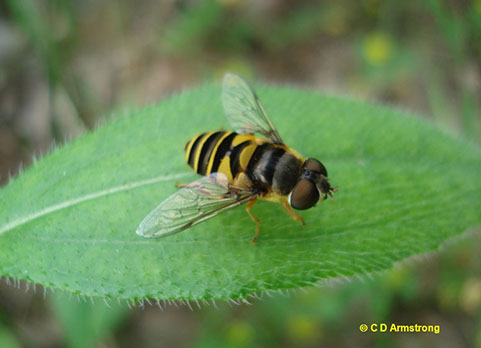
Hover flies (syrphid flies or flower flies)
Description: These nonbiting and nonstinging flies closely resemble wasps and bees, in that they usually have a yellow abdomen encircled by brown or black stripes. Adults are typically one-half to three-quarters of an inch long. Unlike bees and wasps, these insects have only two wings. The legless larvae, sometimes mistaken for tiny slugs, are pale green, clear, or yellow and are usually found in the midst of aphid colonies. The larvae also deposit tar-like excrement around the feeding site.
Value in the home landscape and garden: The larvae are valuable aphid and adelgid predators, capable of consuming over 400 aphids before pupating. Providing food for the nectar- and pollen-feeding adults by planting flowers will encourage them to lay eggs in the landscape or garden. Hover flies are excellent at detecting and attacking even low numbers of aphids.
Predatory bugs
These predatory bugs also feed on nectar and pollen.
Big-eyed bugs are aptly named insects that are about one-eighth inch long, black and white, with silvery wings and large, bulging eyes on the sides of the head. Big-eyed bugs are important predators of chinch bugs (with which they are often confused). They also feed on small caterpillars, mites, insect eggs, and any other insect that they can catch and subdue. Adults are commonly found on flowers.

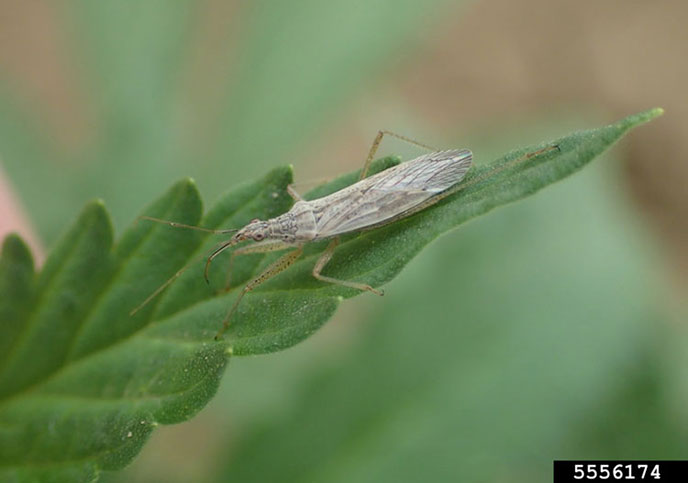
Damsel bugs are usually one- to three-eighths inch long, and gray, brown, or black. The most common ones are much narrower than they are wide and have long legs, with the first pair thicker than the other two pairs. Damsel bugs’ prey include aphids, small caterpillars, leafhoppers, plant bugs, and insect eggs.
Minute pirate bugs are tiny (one-eighth to one-quarter inch long) black and white insects that feed on thrips, mites, insect eggs, and any kind of insect that they can catch.
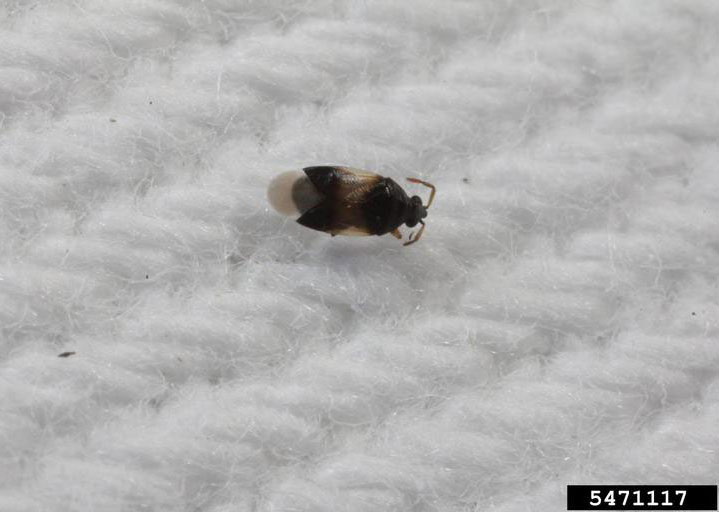
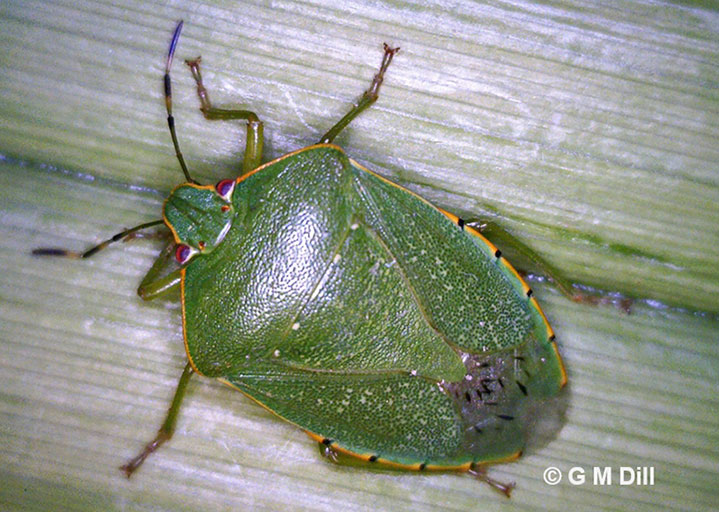
Predaceous stink bugs attack over 100 types of insects, especially leaf beetle larvae and caterpillars. This predator can be distinguished from its plant-feeding relatives by the presence of a distinct spike on each side of its “shoulders” (actually the thorax), just behind the head.
Predatory wasps
Description: The bald-faced hornet (Vespula maculata) is five-eighths to three-quarters of an inch long, with black and white on the head, thorax, and abdomen, and produces large, enclosed paper nests. Yellow jackets (Vespula spp.), the most aggressive wasps in Maine, nest in the ground or in enclosed paper nests, and are one-half to five-eighths inch long, with black and yellow stripes. Paper wasps are one-half to one inch long, brown with black and yellow stripes, and produce open-faced nests. Populations of all three species peak in late summer.
Value in the home landscape and garden: Yellow jackets, bald-faced hornets, and paper wasps are important predators of caterpillars and other soft-bodied insects. Because of this, only destroy nests (taking all appropriate safety precautions) where they pose a hazard to people or pets.
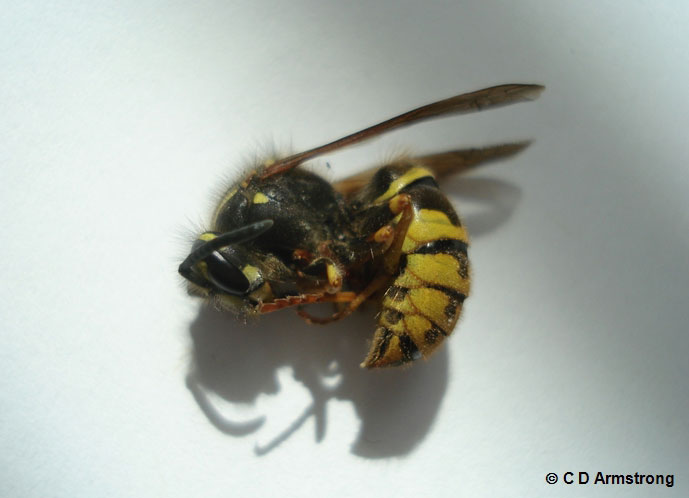
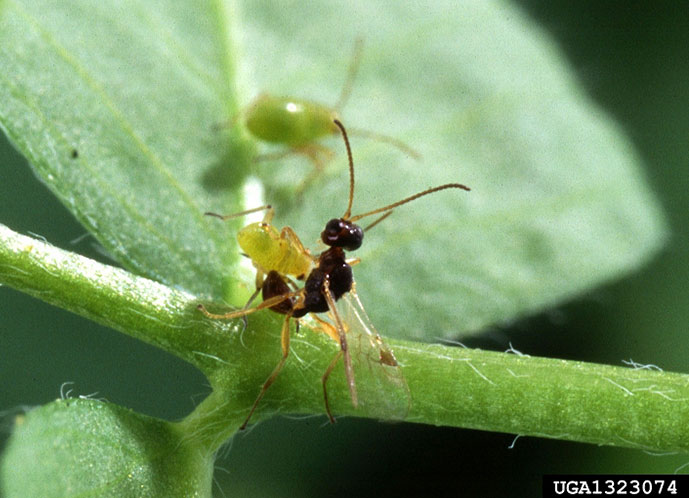
Parasitic wasps
Description: This is a large group of insects with many different families. While some can be as long as 1 5/8 inches (the cicada killer), most parasitic wasps are tiny, black, and less than an eighth of an inch long, and as such, are frequently overlooked.
If you see an aphid that is swollen, puffed out, and tan in color, the chances are that it has been attacked by a parasitic wasp that has placed her egg inside the aphid. Once the egg hatches, the larva eats the aphid from the inside out, pupates, and cuts a circular exit hole from which the adult emerges. Other parasitic wasps lay multiple eggs in a caterpillar or other host. Many times, you’ll see a caterpillar such as a hornworm, with white, egg-like structures on its back. These are pupae of parasitic wasps that have completed development inside the severely weakened and soon-to-be-deceased caterpillar.
Value in the home landscape and garden: This is another important, under-appreciated, and poorly understood group. Parasitic wasps attack aphids, many types of caterpillars, cicadas, lace bugs, scale insects, whiteflies, sawfly larvae, ants, leafminers, and insect pupae. They also attack the eggs of insects such as codling moths, tomato hornworms, cabbage loopers, imported cabbageworms, and European corn borers.
Parasitic flies (tachinid flies)
Description and value in the home landscape and garden: This is a diverse group of over 1,300 North American species, some of which are often mistaken for houseflies, bees, or wasps. Many lay eggs on their host. The eggs hatch and the maggots bore into their host, feed, and complete development. Hosts include caterpillars (including gypsy moth caterpillars), beetles (including Japanese beetles), sawfly larvae, true bugs, and grasshoppers and their relatives.
This is just a small sample of the beneficials that help control pests in your home landscape.
Attracting and Sustaining “Good Bugs”
- Develop a tolerance for some damage by arthropods to your plants; many plants can tolerate low levels of pest damage with few ill effects.
- Provide shelter. Leaving some leaf litter and debris under shrubs may provide beneficial arthropods a place to hide during adverse conditions such as hot summer days.
- Increase the diversity of your landscape. Grow a wide assortment of plants to create habitat for a wide range of natural enemies. Also, diverse plantings of the right species that are pest and disease resistant make it less likely that pests will cause problems.
- Do not use zapper lights that electrocute insects. In study at the University of Delaware, these lights killed many more beneficial insects than pests.
- Ensure a continuous supply of floral nectar and pollen by selecting plants with a succession of flowering times. Nectar is an important source of carbohydrates that provide energy; pollen is a protein source. Because the appetites of beneficials may peak before your garden does, plant an early bloomer, such as sweet alyssum or pansy. Include late-blooming plants such as goldenrod and aster species, many of which colonize areas on their own.
- Choose their favorite plants. Many beneficials like tiny flowers that offer both pollen and nectar.
Best Flower Structures for Beneficial Arthropods
- Umbels. These little flowers form umbrella-like clusters. They include dill, Queen Anne’s lace, angelica, fennel, and yarrow.
- Composites. These have a center of tiny true flowers surrounded by rays, and include sunflowers, coneflowers, daisies, cosmos, and asters.
- Spikes. Look for plants with flowers similar to lavender, goldenrod, and hyssop.
- Cups. Small insects won’t get trapped in the almost flat cups of evening primrose or buttercups.
Managing Your Yard as Habitat for Beneficial Arthropods
“Think first . . . spray last!” as the Maine Department of Agriculture says—and UMaine Cooperative Extension strongly agrees. Managing for beneficials includes nonchemical methods such as pruning, hand-picking, covering plants with netting, or other means. For example, Eastern tent caterpillar and fall webworm nests, small infestations of sawfly larvae, and other pests can be simply pruned out of the tree, placed in a tightly sealed bag, and sent to the landfill.
Go looking for trouble: Walk around your yard looking for pests, diseases, and other plant stressors every two weeks or so. It is generally easier to control pests when they’re small. Bacillus thuringiensis kurstaki (B.t.k.), an organically approved, natural pesticide for caterpillar control (which can also kill nontarget butterfly and moth caterpillars), is more effective against smaller or younger caterpillars than larger ones. The same is true for other less toxic pesticides like horticultural oil or insecticidal soap.
By regularly inspecting your plants for pests, diseases, and environmental stress, you can often detect a potential problem early. Don’t forget to scout for beneficials, which may be providing control. This allows you to make an informed decision among the possible choices: let nature (i.e. beneficial arthropods) take its course, opt for some of the nonchemical methods mentioned above, purchase and release natural enemies, or perform a “spot spray” over a limited area, instead of applying large volumes of pesticides harmful to natural enemies.
Know your foe: Just because an insect is on a plant doesn’t mean that it’s doing damage. Remember, it has been estimated that over 97 percent of the insects usually seen in the home landscape are either beneficial to people or innocent bystanders. Make use of University Cooperative Extension personnel, online or printed Extension fact sheets, or reference books to help identify the suspect. Identification is important: it is illegal (and often ineffective) to apply a pesticide to a pest or plant that does not appear on the pesticide label. Plants that are not on the pesticide label may also be harmed by it. Proper identification may allow you to avoid the use of a broad-spectrum pesticide that kills not only the pest you’re trying to control, but many beneficials as well.
Avoid Problems by Keeping Plants Healthy
Pests and diseases are notorious for “kicking a plant while it’s down.” Plants that are stressed are generally more susceptible than plants that are healthy and strong. Allowing plants to become stressed can result in the need for more drastic control measures—including pesticides—that could harm beneficials and other non-target species.
Plant stressors include
- Moisture stress (too much or too little water).
- Improper planting sites. Placing a shade-loving plant in full sun (or the reverse), and placing plants in areas of poor air circulation (which can lead to problems with fungi) are common mistakes that stress a plant and may leave it more susceptible to pests, diseases, or environmental problems. If a plant continually has pest or disease problems, you may want to replace it. Choose a variety that is resistant or not susceptible to these problems. Horticulturists can help identify these resistant plants or suggest plants that are better suited for problem areas such as those with poor drainage, compacted soil, or the potential for road salt, wind, or cold/heat damage.
- Improper mulching. Mulch should be pulled back a bit from the base of the plant.
- Improper fertilization. One common mistake is to overfertilize plants with nitrogen. This actually favors pests (such as aphids, mites, and the black vine weevil) more than it helps the plant. Soil tests can be used to determine if or how much fertilizer is needed.
Encourage or Import?
We have advocated managing your yard as habitat for beneficial arthropods. Another way to bring beneficials into your yard is to buy specific species for release.2 However, while the introduction of beneficials into a closed greenhouse system can be quite helpful, there are many challenges in introducing them into the unenclosed habitat of your yard. For example, a large percentage of lady beetles, when purchased and released, will fly away from your yard and therefore have little effect on your pests. If you decide to purchase and release a species of beneficial arthropod in your yard, follow these steps to maximize the benefits and minimize any negative impacts:
- Identify the pests that need to be controlled, and learn which beneficial arthropod is appropriate for your situation. Many companies have catalogs or technical support to help you.
- Learn the best time to release the beneficial arthropod based on the life cycle of the pest.
- Know the quantity and life stage (e.g. larva or adult) of the beneficial arthropod that will be most effective.
- Provide a safe delivery address where the shipment of beneficials will be cared for as soon as it arrives.
- Learn the proper release requirements, such as time of day, food and water needs, etc.
Everything Is Connected
Managing for beneficials is part of enhancing habitat for all wildlife, including birds, reptiles, amphibians and mammals, as well as arthropods. Many wildlife species are important pest control agents in their own right because arthropods make up all or part of their diet, providing necessary protein. Learning about wildlife and its habitat is the best way to avoid actions that have unintended consequences.
1 Colin Stewart, S. Kristine Braman, and Beverly Sparks, “Abundance of Beneficial Arthropods on Woody Landscape Plants at Commercially-Managed Landscape Sites,” Journal of Environmental Horticulture v20 n2 (2002): 67-72.
2 Charles D. Hunter, California Environmental Protection Agency, Suppliers of Beneficial Organisms in North America.
To learn more about managing arthropods and plant diseases, see our pest management fact sheets and our Home and Garden IPM (Integrated Pest Management) website, or call 1.800.287.0279 (in Maine) or your UMaine Extension county office.
Information in this publication is provided purely for educational purposes. No responsibility is assumed for any problems associated with the use of products or services mentioned. No endorsement of products or companies is intended, nor is criticism of unnamed products or companies implied.
© 2004
Call 800.287.0274 (in Maine), or 207.581.3188, for information on publications and program offerings from University of Maine Cooperative Extension, or visit extension.umaine.edu.
In complying with the letter and spirit of applicable laws and pursuing its own goals of diversity, the University of Maine System does not discriminate on the grounds of race, color, religion, sex, sexual orientation, transgender status, gender, gender identity or expression, ethnicity, national origin, citizenship status, familial status, ancestry, age, disability physical or mental, genetic information, or veterans or military status in employment, education, and all other programs and activities. The University provides reasonable accommodations to qualified individuals with disabilities upon request. The following person has been designated to handle inquiries regarding non-discrimination policies: Director of Equal Opportunity and Title IX Services, 5713 Chadbourne Hall, Room 412, University of Maine, Orono, ME 04469-5713, 207.581.1226, TTY 711 (Maine Relay System).


